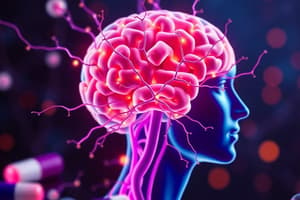Podcast
Questions and Answers
What is the primary effect of sedative anxiolytics?
What is the primary effect of sedative anxiolytics?
- Inducing sleep
- Providing anterograde amnesia
- Reducing anxiety and exerting a calming effect (correct)
- Suppressing reflexes
Which of the following benzodiazepines is classified as short-acting?
Which of the following benzodiazepines is classified as short-acting?
- Alprazolam
- Diazepam
- Flurazepam
- Triazolam (correct)
What is the primary effect of hypnotic agents?
What is the primary effect of hypnotic agents?
- Reducing anxiety
- Providing anterograde amnesia
- Inducing drowsiness and encouraging sleep (correct)
- Suppressing reflexes
Which of the following is an atypical sedative-hypnotic agent?
Which of the following is an atypical sedative-hypnotic agent?
What is the effect of benzodiazepines on REM sleep?
What is the effect of benzodiazepines on REM sleep?
What is the primary use of Thiopental in anesthesia?
What is the primary use of Thiopental in anesthesia?
What is the main inhibitory neurotransmitter in the CNS that benzodiazepine binds to?
What is the main inhibitory neurotransmitter in the CNS that benzodiazepine binds to?
Which of the following is a potential side effect of benzodiazepine in the cardiovascular system?
Which of the following is a potential side effect of benzodiazepine in the cardiovascular system?
What is the primary indication for benzodiazepine in anesthesia?
What is the primary indication for benzodiazepine in anesthesia?
What is the mechanism of action of flumazenil?
What is the mechanism of action of flumazenil?
Which of the following is a potential interaction with benzodiazepine?
Which of the following is a potential interaction with benzodiazepine?
What is the resulting effect of benzodiazepine binding to the GABA receptor?
What is the resulting effect of benzodiazepine binding to the GABA receptor?
What is the effect of barbiturates on the flow of chloride through channels?
What is the effect of barbiturates on the flow of chloride through channels?
What is a use of Phenobarbital?
What is a use of Phenobarbital?
What is a common toxicity of barbiturates?
What is a common toxicity of barbiturates?
What is an advantage of Zolpidem?
What is an advantage of Zolpidem?
What receptors does Ramelteon act on?
What receptors does Ramelteon act on?
What enzymes metabolize Ramelteon?
What enzymes metabolize Ramelteon?
Flashcards are hidden until you start studying
Study Notes
Benzodiazepines
- Benzodiazepines act by binding to the gamma subunit of GABA A receptors, enhancing GABA's effect, and increasing chloride channel opening frequency.
- Indications include seizure disorders, alcohol withdrawal, anxiety disorders, insomnia, and as induction agents in anesthesia.
- Side effects encompass cardiovascular issues (hypotension), musculoskeletal effects (muscle weakness), neurologic effects (amnesia, drowsiness, euphoria, ataxia), respiratory depression, dermatologic rashes, and genitourinary difficulties.
- Drug interactions can occur with strong inhibitors or inducers of CYP3A4 or CYP2C19.
Flumazenil
- Flumazenil is a benzodiazepine antagonist used as a reversal agent in overdose cases.
- It competes for the same binding site as benzodiazepines.
Barbiturates
- Classified into ultra-short (Thiopental), short (Secobarbital), intermediate (Amobarbital), and long-acting (Phenobarbital) categories.
- May antagonize glutamic acid, enhance GABA effects, and increase chloride flow through channels.
- Commonly used for sedation, induction of anesthesia, seizure control, and treatment of neonatal hyperbilirubinemia.
- Toxicity includes oversedation, rapid tolerance, high abuse potential, and risk of acute overdose leading to coma, respiratory depression, cardiovascular collapse, and renal failure.
Atypical Agents
- Zolpidem acts on benzodiazepine receptors, providing significant sedation with minimal anxiolytic action; less likely to cause physical dependence.
- Ramelteon functions as an agonist at MT1 and MT2 receptors in the suprachiasmatic nucleus, with low abuse risk and is metabolized by CYP1A2 and 2C9, interacting with fluvoxamine and azole antifungals.
Sedative-Hypnotic Overview
- Sedatives reduce anxiety and produce a calming effect, while hypnotics promote drowsiness and sleep maintenance.
- Newer unclassified agents demonstrate a flatter dose-response curve compared to traditional benzodiazepines.
Dose-Response Characteristics
- Benzodiazepines can induce hypnosis, which reduces REM sleep and can cause REM rebound.
- They are associated with amnesia and suppressed reflexes during anesthesia; short-acting options for IV use include Lorazepam and Diazepam.
Studying That Suits You
Use AI to generate personalized quizzes and flashcards to suit your learning preferences.




